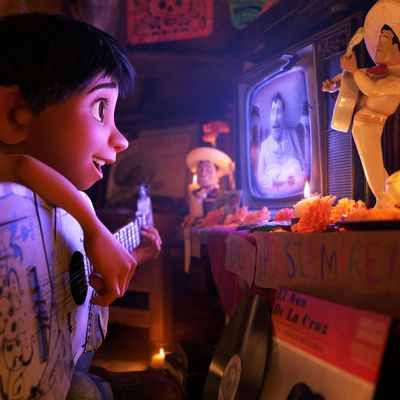
As obstacles for the heroes of children’s films go, Miguel’s is a little, shall we say, cerebral. The rebellious 12-year-old protagonist of Coco longs to be a musician, but his family of shoemakers … hates music. Not just the music of local hero and “greatest musician that ever lived” Ernesto de la Cruz, nor just guitar music. All music. This goes back, we are told in a colorful if staid papel picado opening sequence, to his great-great-grandfather, who left his wife and daughter to chase his dreams of stardom, and his wife passed the grudge down through three generations. But dramatically, it’s a little bit of a head-scratcher — like someone took a plot summary of Ratatouille and hastily replaced every mention of the word “cooking” with “music,” assuming the tried-and-true Pixar formula of self-discovery and individualism would hold strong.
It does, eventually, but there is a lot to be nervous about in the opening 15 or so minutes of Coco that has nothing to do with the plot. This is Pixar’s big and at one point embattled Day of the Dead project, which drew some ill will when Disney attempted to trademark the name of the Mexican holiday itself in 2013. The company backed down after outcry from the Mexican-American community, changed the title of the film to Coco, and promoted co-writer Adrian Molina to co-director alongside longtime Pixar helmer Lee Unkrich. The studio even hired one of their most vocal critics, cartoonist Lalo Alcaraz, to come aboard the project as a cultural adviser. In short, there was much backside-covering in the making of this film, and much insurance taken out against the dreaded “appropriation” label, and it shows a little in the film’s creaky, homework-y setup.
But once it gets going — once young Miguel runs away and is transported to the land of the Dead by strumming on de la Cruz’s magical guitar — the film loosens up considerably. Coco is as indebted to Ratatouille as it is to Studio Ghibli’s Spirited Away, but the combination of sensibilities and the colorful, semi-spooky milieu of the afterlife realm where most of the film is set is not at all unwelcome. The dead are envisioned as mournful yet goofy skeletons, a cutened-up version of those winningly macabre Día de Muertos dioramas found in souvenir shops, whose limbs and heads have a habit of coming undone and skittering back together. After running away from his deceased family, who also hate music, he befriends Hector (voiced by Gael García Bernal), a particularly sad case who is unable to cross back into the realm of the living because nobody has put his picture out on their ofrendas. (The film depicts a vaguely totalitarian immigration and customs system at the border between the dead and the living, which may be the darkest joke of all in a film full of them.) The two team up to get Miguel an audience with his de la Cruz, whom Miguel believes is his departed great-great-grandfather, and who may be able to send him back to the land of the living with his blessing for Miguel’s musical aspirations.
The rules of the land of the dead, and how its denizens are able to cross back and forth if they’re lucky, are a little byzantine, a combination of traditional lore and some newfangled plot mechanics. One of the films best visual treats are its alebrijes, the colorful fantastical creatures from Mexican folk art, rendered here as electrically colored lizards and gryphons that seem to pop off the screen even without the aid of 3-D. But the death mechanics also lead the film to some pretty dark territory concerning the “final death” that awaits spirits who are no longer remembered by the living. This becomes a ticking clock for Hector, and perhaps the most horrific fate faced by any character in Disney’s entire run: to cease not just being, but even existing as an idea. Pixar never found a piteous straw man they couldn’t use to wring tears out of the audience, and Hector joins Inside Out’s Bing Bong in the studio’s Hall of Fame of Emotional Manipulation.
I’d argue Coco, with its strong messages about family and tradition, doesn’t need such tricks, especially once the characters start singing. The film’s songs — which had better be good, given how arbitrarily forbidden they are — were co-written by Molina and Frozen duo Kristen Anderson-Lopez and Robert Lopez, and they range from pleasantly nap-inducing to outright rousing. A sequence at a Dead talent show is an absolute delight, featuring a host of multi-instrumental skeletons and culminating with Miguel and Hector singing an adorable, instantly catchy little ditty called “Un Poco Loco.” I won’t be mad if this becomes the film’s “Let It Go”; it’s certainly easier to sing. Justin Bieber, if you’re listening and want a chance to redeem your phonetic Spanish skills, it may be time to hop on the Disney brand-synergy train and crank out the inevitable pop radio cover.

